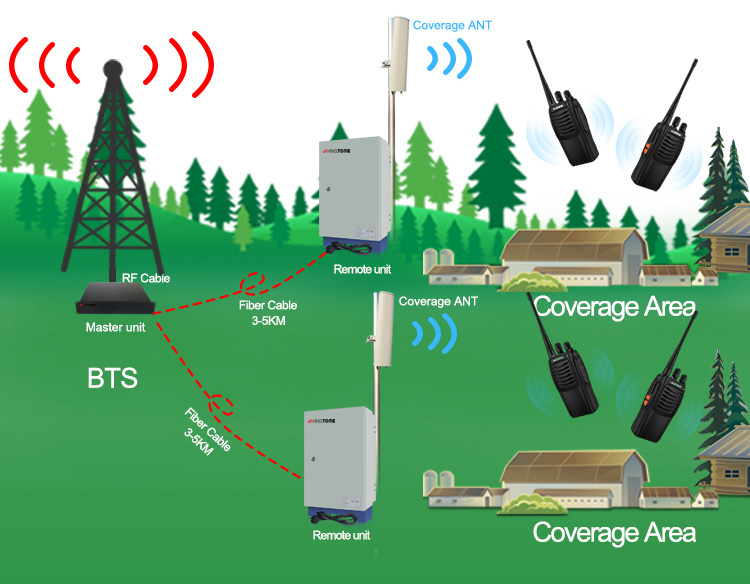TETRA (Terrestrial Trunked Radio) is a digital radio standard frequently utilized by public safety and other critical communication organizations. In areas where the signal from a TETRA base station is weak or unavailable, repeaters are used to extend coverage. Among these, Sub-band Selective Repeaters (SSRs), often used in conjunction with an Optical Master Unit (OMU), offer a particularly effective solution.
How it works
1,OMU as the Hub: The OMU, connected to a TETRA base station (BTS) or another repeater, receives the RF signal.
2,RF to Optical Conversion: The OMU converts the incoming RF signals into optical signals for transmission over fiber optic cables.
3,Fiber Distribution: The optical signals are then distributed via fiber optic cables to one or more remote sub-band selective repeaters (SSRs).
4,SSRs as Remote Amplifiers: The SSRs are strategically placed in areas needing improved coverage, such as buildings, tunnels, or challenging terrain.
5,Optical to RF Conversion & Amplification: The SSR converts the optical signal back to RF, amplifies it, and retransmits it on a different frequency to avoid interference. This retransmission provides a strong signal within the coverage area.
6,Uplink Process: Similarly, in the uplink direction, the SSR receives signals from TETRA handsets, converts them to optical signals, and sends them back to the OMU via the fiber optic cable, which then transmits the RF signal to the base station.
Advantages of Sub-band Selective Repeaters (SSR)
1,Improved Signal Quality: By selectively amplifying and regenerating only the necessary sub-bands, SSRs minimize noise and interference, resulting in clearer voice and data communication.
2,Targeted Coverage Extension: SSRs are ideal for extending coverage into specific areas like tunnels, basements, or valleys where conventional base station signals are weak or blocked.
3,Efficient Spectrum Use: Focusing on particular sub-bands helps to avoid interfering with adjacent channels, optimizing spectral efficiency.
4,Reduced Interference: SSRs provide better out-of-band rejection, minimizing unwanted interference with neighboring channels and base stations.
5,Faster and Easier Deployment: Digital filtering technology allows for quicker and simpler configuration of frequency and bandwidth settings, streamlining installation and maintenance.
6,Remote Monitoring and Control: Some SSRs offer remote monitoring and configuration capabilities, allowing for efficient management of the coverage system.
In essence, TETRA OMU-based sub-band selective repeaters provide a robust and efficient solution for extending and enhancing TETRA network coverage in challenging environments, ensuring reliable and secure communication for critical operations.
- OMU as the Hub: The OMU, connected to a TETRA base station (BTS) or another repeater, receives the RF signal.
- RF to Optical Conversion: The OMU converts the incoming RF signals into optical signals for transmission over fiber optic cables.
- Fiber Distribution: The optical signals are then distributed via fiber optic cables to one or more remote sub-band selective repeaters (SSRs).
- SSRs as Remote Amplifiers: The SSRs are strategically placed in areas needing improved coverage, such as buildings, tunnels, or challenging terrain.
- Optical to RF Conversion & Amplification: The SSR converts the optical signal back to RF, amplifies it, and retransmits it on a different frequency to avoid interference. This retransmission provides a strong signal within the coverage area.
- Uplink Process: Similarly, in the uplink direction, the SSR receives signals from TETRA handsets, converts them to optical signals, and sends them back to the OMU via the fiber optic cable, which then transmits the RF signal to the base station.
- Improved Signal Quality: By selectively amplifying and regenerating only the necessary sub-bands, SSRs minimize noise and interference, resulting in clearer voice and data communication.
- Targeted Coverage Extension: SSRs are ideal for extending coverage into specific areas like tunnels, basements, or valleys where conventional base station signals are weak or blocked.
- Efficient Spectrum Use: Focusing on particular sub-bands helps to avoid interfering with adjacent channels, optimizing spectral efficiency.
- Reduced Interference: SSRs provide better out-of-band rejection, minimizing unwanted interference with neighboring channels and base stations.
- Faster and Easier Deployment: Digital filtering technology allows for quicker and simpler configuration of frequency and bandwidth settings, streamlining installation and maintenance.
- Remote Monitoring and Control: Some SSRs offer remote monitoring and configuration capabilities, allowing for efficient management of the coverage system.
Post time: Aug-21-2025


